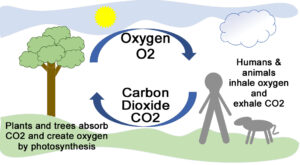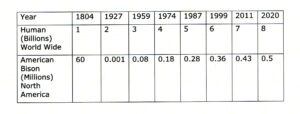Human Impacts on the Environment
Updated:by John Williams
Global warming is on our minds. We love the natural world we live in, and it is changing. The warming is starting to have impacts which we can see and feel. More changes are predicted. But climate change caused by greenhouse gasses is not the only challenge facing our planet.
Articles have appeared in Mountain Passages addressing climate change and protecting the environment. Most recently, the Spring 2020 issue featured We Must Take Action Regarding Climate Change by Paul Hopkins and the March-April 2019 contained an article by Janis & Arianna Stokes, Waste Not on how to evaluate and reduce our household waste stream. Both of these articles were intended to raise awareness, understanding and promote earth friendly behaviors.
This article is intended to do the same by reviewing some of the major environmental challenges we and the planet face in 2021 and the future.
Global Warming and Greenhouse Gases
A great deal of emphasis is placed on carbon compound emissions as the cause of environmental change. Environmental change occurs continuously as explained by Paul Hopkins in his article, but recent human impacts have greatly accelerated the changes to ecosystems. Anyone who has had the experience of seeing the toe of a glacier knows the glaciers are melting at a much faster rate than they have in the recent past. In the northeast, the summers have been warmer, and the winters milder. Further south, hurricanes and tropical storms are becoming more frequent and intense. Rising temperatures will affect ecosystems in the oceans and on land as average temperatures slowly rise.

Ice is melting throughout the world.
We are familiar with the big targets in the effort to reduce adding excess carbon dioxide and other greenhouse gases into the atmosphere. The biggest sources are power plants, transportation (automobiles, trucks, busses, and aircraft), agriculture and livestock, our homes, and industry. Just think about the thousands of trucks making deliveries to stores and to our homes which swarm about like global warming busy bees. How does our lifestyle contribute to this?
Modern products and luxuries which seem necessary today all contribute to the excess generation of carbon dioxide, the primary greenhouse gas. Generation of other greenhouse gasses in excess are also largely attributed to human activity. Essentially, everything which involves the use of a powered device contributes excess carbon dioxide to earth’s atmosphere. Automobiles, both gas and electric, lawn mowers and leaf blowers, cordless drills, hair dryers and irons, toasters, gas grills, and air conditioners, heating systems and portable heaters, and even computers and cell phones contribute to emissions of greenhouse gasses which cause global warming.
Essentially every electric device operated by consumers indirectly adds carbon emissions to the atmosphere, due to the use of electricity produced by burning fossil fuels, such as oil, gas, or coal, or wood.
Even burning bio-mass (forestry wood & wood product waste) generates carbon emissions. This includes your campfire and backyard wood fire pit.
Yes, even “green” energy alternatives, such as solar panels and wind turbines, contribute to global warming because of the energy consumption during their manufacture, transport and installation.
Most of our energy depends on fire, and fire consumes oxygen from the air and releases carbon dioxide.

Plants take up carbon dioxide and produce oxygen while all aerobic organisms take up oxygen and release carbon dioxide.
Over the years, many of us were introduced to the biological cycle of oxygen and carbon dioxide. Except for anaerobes living in small niches that are free of oxygen, life depends on oxygen. We take the oxygen in the air for granted. We inhale oxygen and exhale carbon dioxide. Plants, such as algae, grass and trees are critical to the other side of this cycle, they absorb carbon dioxide and use it to produce their biomass and oxygen. While plants also use oxygen, they produce more than they need and release it to the atmosphere.
In an undisturbed environment, the cycle is in balance, and the amount of carbon dioxide produced is roughly equal to the amount consumed. However, humans have upset the process by extracting fossil fuels, which are primarily the remains of ancient plants, and burning these fuels for energy or even worse for disposal, leading to steady increases in the levels of carbon dioxide.
This imbalance and the continuing rise in carbon dioxide levels in the atmosphere is driving global warming and climate change.
Extinction of Species
During the last 50 years great improvements have been made in North America and Europe to clean up rivers, lakes and oceans, and the air. But while there have improvements, the impact of human population around the world continues to cause adverse impacts to wildlife species and eco-systems which will be very difficult or impossible to reverse. Some species have become extinct, and many more are predicted to become extinct in the next 50 years by the United Nations.
One million species are at risk of extinction, a UN report warned in May, 2019. This dire prediction is based on human impact on the planet which has occurred and is predicted in the future. The report indicates greater than 500,000 terrestrial species are facing insufficient habitat for long term survival. While climate change is a major contributor to this species die-off, other factors play a significant role, including the overpopulation of humans, and encroachment on and ultimate elimination of species habitat. For many iconic species, such as elephants and rhinos, as well as less well-known species, poaching is frequently a significant threat.
Green Planet, Fewer Trees
Our planet is often portrayed as green for the land and blue for the oceans. Satellite photos show that the land is actually divided between green and brown. We know that the green on the surface is green because of the presence of plants that are essential to our survival.
Why is it that man is constantly clearing the forest from the land thereby removing the green? Why can’t we stop Brazil from clearing the Amazon? Why don’t we stop the clearing of forests in North America, including New Hampshire? These trees are essential to our long-term survival.
I saw acres of trees being cleared in New Hampshire in 2020 to construct a solar farm. Hmmm, does that help, or does it hurt? Trees cleanse the air and absorb the carbon molecules and produce essential oxygen. But that is not all that trees, plants, and grasses do for us every day. Trees cool our environment. Trees and other plants provide natural air conditioning by evaporative cooling. Native trees and vegetation provide great environmental benefits. When trees are removed for land development, the negative impacts which add to global warming are increased. We like and value trees. So, rather than harvesting them, why don’t we save the trees, plant trees, and even hug the trees? While some harvesting of trees in inevitable and may even be beneficial, we should think twice before we clear land to build another shopping mall or commercial facility.
This is not a new problem. Western Europe and Eastern North America were once covered by dense forests. But with the advance of man, these forests were cut down for fuel and building materials as well as to open land for agriculture. However, just because the problem is long standing doesn’t mean it isn’t a problem today!
Land development
As the world population grows, native swaths of land are developed and permanently modified, reducing wildlife habitat and harming the carbon dioxide to oxygen cycle, and reducing nature’s ways of keeping the earth cool.
In September 2020, an excellent environmental documentary was televised on NHPBS. The program, The Merrimack: River at Risk was created by the Society for the Protection of New Hampshire Forests and described how land development in New Hampshire threatens the future of the Merrimack River. This program is still available for viewing on the Forest Society’s website (https://forestsociety.org/project/merrimack-river-risk).
Clearing of forest and farm land in New Hampshire destroys the buffer which provides cleansing for both water and air. Development of land, converting open land to pavement and buildings adds to permanent environmental damage. Land development increases flood levels due to increased run off, increases pollution in waterways, damages the carbon reducing benefits of native trees and plants, and permanently reduces the natural air cooling that undeveloped land provides.
In contrast to a grassland or forest, pavement gets hot in the summer; it absorbs solar radiation, heats up and then radiates heat into our environment for hours. Have you walked barefoot or in light shoes across a black parking lot on a hot summer day and felt the heat on your soles? Roof tops and buildings also absorb solar radiation and heat our local environment. Multiply each home, business and street by many millions and we people and all of our paved areas and buildings are heating the environment beyond its ability to self-cool to previous temperatures.
Even without the heat trapping effect of increased CO2 levels in our atmosphere, temperatures would be rising.
Population Growth
When one considers the environmental issues which we face, we recognize that the vast majority of the problems are caused by human impact on our earth. The world’s population has increased dramatically during the last 200 years, and most of the negative environmental impacts are multiplied by the population.
As the human population continues to grow, global warming and environmental losses will continue to grow unless fundamental changes are made. More people require more conversion of natural land to farming, housing, and commercial development. Each person creates a “footprint” on the earth. In the modernized regions of the world the footprint is greater than non-developed regions, and has a greater negative impact. However, people in the less developed regions seek to emulate the lifestyle of the more affluent.
Each human footprint includes fractions of the following: paving of streets driveways, and walkways, construction of homes and apartments, use of automobiles and lawn tractors, air conditioners and heating systems, computers, and cell phones, and disposal of one time use metal, plastic and paper products and styrofoam coffee cups. The list can go on and on.
Increasing population also drives necessary increases in infrastructure, such as more trucks carrying food for distribution. While the human population grows at a rate of 1 billion every 10-12 years, wildlife population declines due to habitat loss, creating a great imbalance. For example, consider the great loss of the bison population in North America shown in contrast with the worldwide growth of human population.

As human population expanded, the population of bison plummeted partially recovering only recently.
If somehow the population could remain at the current level, the human impact would generally remain at the current level. With some tweaks and tuning we might actually reduce carbon emissions and lower our individual waste stream or at least prevent further degradation as other populations throughout the world increase their consumption. If there is a moratorium on land development world-wide today, the wildlife habitat loss will be slowed or even stopped.
But, what impact can we as individuals have on either of those scenarios?
Changing Times and Silver Linings
The year 2020 has been a strange one, and created many short-term and possibly long-term changes. It is great that people were encouraged to “get outside”, and they did in droves. While long time hikers might be dismayed at the throngs of cars lining the roads at each trailhead, it is great to see so many people getting out to enjoy nature and possibly learning why it is important to protect it. But this increase is putting more pressure on our forest trails and the natural environment.
Another silver lining in the 2020 pandemic is the vast reduction in commuting to and from work every day. This welcome change substantially reduced the carbon dioxide emissions from many autos. If office workers continue to work from home following the pandemic, the reduction in greenhouse gasses will help to achieve some of the desired greenhouse gas reduction objectives. That is a silver lining of the pandemic, but may come at the cost of widening a cultural divide in this country.
The Future of Our Planet
Consider the environmental issues discussed in this article. It is long on problems and short on solutions. If you want to help solve these environmental challenges, look in the mirror and consider the impact created by every one of your actions. Think of the next generations and how the imbalance of nature will change. We all need to consider what small steps and more difficult large steps are needed to preserve our planet. Our challenge is to reduce our impacts and to learn to live with the impacts we cannot change.
Look for an article in the future on small changes we can make to be more earth friendly.